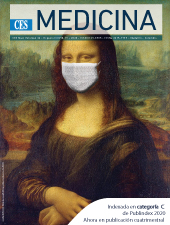Oxygen therapy in COVID-19: practical considerations prior to invasive mechanical ventilation. Simple guide
DOI:
https://doi.org/10.21615/cesmedicina.34.COVID-19.16Keywords:
Oxigen therapy, Monitoring, Nasal cannula, COVID-19Abstract
Patients with acute respiratory distress syndrome (ARDS) secondary to COVID-19 have an atypical presentation, with a discrepancy between acceptable lung mechanics and pronounced hypoxia. Each of the supplemental oxygen methods used in clinical practice in patients with COVID-19 infection has its indications, advantages, and disadvantages. The nasal cannula is the most common system, recommended in cases of mild hypoxia. Venturi system using accurate FiO2 with higher oxygen flow, and the non-rebreather mask that would normally be used in the absence of response with the above-mentioned devices, are at risk of aerosolizing and transmitting infection. A very useful tool is the high-flow nasal cannula, which is well tolerated, can decrease the patient’s work of breathing, and can reduce the rate of tracheal intubation. It could be useful in the absence of available ventilators and when other supplemental oxygen methods are insufficient to achieve SatO2 goals. There are reports where non-invasive ventilation is used, however, it is recommended that if the patient is candidate to invasive ventilation support, it must be initiated without delay. Indications for endotracheal intubation are both clinical and gasimetric, saturation goals are generally 90-96 %, and endotracheal intubation with mechanical ventilation should not be delayed if indicated. Further studies are needed in order to assess the clinical efficacy of supplemental oxygen devices for non-invasive respiratory support in these patients.
Downloads
References
COVID-19 Map. Johns Hopkins Coronavirus Resource Center. [Sitio en Internet]. Available from: https://coronavirus.jhu.edu/map.html
Sohrabi C, Alsafi Z, O’Neill N, Khan M, Kerwan A, Al-Jabir A, et al. World Health Organization declares global emergency: A review of the 2019 novel coronavirus (COVID-19). Int J Surg. 2020;76:71–6.
Gattinoni L, Coppola S, Cressoni M, Busana M, Rossi S, Chiumello D. COVID-19 Does Not Lead to a “Typical” Acute Respiratory Distress Syndrome. Am J Respir Crit Care Med. 2020;201(10):1299–300.
Beeching NJ, Fletcher TE, Fowler R. COVID-19. BMJ Best Practice. Marzo 2020; https://bestpractice.bmj.com/topics/en-gb/3000168
Chica-Meza C, Peña-López LA, Villamarín-Guerrero HF, Moreno-Collazos JE, Rodríguez-Corredor LC, Lozano WM, et al. Cuidado respiratorio en COVID-19. Acta Colomb Cuid Intensivo. 2020. [Epub ahead of print]
Alhazzani W, Møller MH, Arabi YM, Loeb M, Gong MN, Fan E, et al. Surviving Sepsis Campaign: guidelines on the management of critically ill adults with Coronavirus Disease 2019 (COVID-19) . Intensive Care Medicine. Springer Berlin Heidelberg; 2020:1-34. [Epub ahead of print]
Tingbo L, Hongliu C, Yu C, Zuobing C, Qiang F, Weili H, et al. Handbook of COVID-19 Prevention and Treatment. Handb Covid-19, Prev Treat. 2020;68.
Ramanathan K, Antognini D, Combes A, Paden M, Zakhary B, Ogino M, et al. Planning and provision of ECMO services for severe ARDS during the COVID-19 pandemic and other outbreaks of emerging infectious diseases. Lancet Respir Med. 2020;8(5):518–26.
Caputo ND, Strayer RJ, Levitan R. Early Self‐Proning in Awake, Non‐intubated Patients in the Emergency Department: A Single ED’s Experience during the COVID‐19 Pandemic. Acad Emerg Med. 2020;375–8.
Whittle JS, Pavlov I, Sacchetti AD, Atwood C, Rosenberg MS. Respiratory support for adult patients with COVID‐19. J Am Coll Emerg Physicians Open. 2020;1(2):95–101.
Hui DSC, Chan MTV, Chow B. Aerosol dispersion during various respiratory therapies: a risk assessment model of nosocomial infection to health care workers. Hong Kong Med J. 2020;20(4):S9-13.
Ferioli M, Cisternino C, Leo V, Pisani L, Palange P, Nava S. Protecting healthcare workers from SARS-CoV-2 infection: practical indications. Eur Respir Rev. 2020; 29: 200068.
Li J, Fink JB, Ehrmann S. High-flow nasal cannula for COVID-19 patients: low risk of bio-aerosol dispersion. Eur Respir J. 2020;55:2000892.
Hui DS, Chow BK, Lo T, Tsang OTY, Ko FW, Ng SS, et al. Exhaled air dispersion during high-flow nasal cannula therapy versus CPAP via different masks. Eur Respir J. 2019;53(4):1802339.
Xu Z, Li Y, Zhou J, Li X, Huang Y, Liu X, et al. High-flow nasal cannula in adults with acute respiratory failure and after extubation: a systematic review and meta-analysis. Respir Res. 2018;19(1):4–13.
Wang K, Zhao W, Li J, Shu W, Duan J. The experience of high-flow nasal cannula in hospitalized patients with 2019 novel coronavirus-infected pneumonia in two hospitals of Chongqing, China. Ann Intensive Care. 2020;10(1):0–4.
Xia JG, Zhao JP, Cheng ZS, Hu Y, Duan J, Zhan QY. Non-invasive respiratory support for patients with novel coronavirus pneumonia: clinical efficacy and reduction in risk of infection transmission. Chin Med J (Engl). 2020;0(9):1109–11.
Gürün Kaya A, Öz M, Erol S, Çiftçi F, Çiledag Aydin, Kaya A. High flow nasal cannula in COVID-19: a literature review. Tuberk Toraks. 2020;68(2):168-174.
Lyons C, Callaghan M. The use of high-flow nasal oxygen in COVID-19. Anaesthesia. 2020, 75, 843–847.
Ñamendys-Silva SA. Respiratory support for patients with COVID-19 infection. Lancet Respir Med. 2020;8(4):e18.
Rochwerg B, Brochard L, Elliott MW, Hess D, Hill NS, Nava S, et al. Official ERS/ATS clinical practice guidelines: Noninvasive ventilation for acute respiratory failure. Eur Respir J. 2017;50(4):1602426.
Wilcox SR. Management of respiratory failure due to covid-19. BMJ. 2020;369:m1786.
Downloads
Published
How to Cite
Issue
Section
License
Copyright (c) 2020 CES Medicina

This work is licensed under a Creative Commons Attribution-NonCommercial-ShareAlike 4.0 International License.
Derechos de reproducción (copyright)
Cada manuscrito se acompañará de una declaración en la que se especifique que los materiales son inéditos, que no han sido publicados anteriormente en formato impreso o electrónico y que no se presentarán a ningún otro medio antes de conocer la decisión de la revista. En todo caso, cualquier publicación anterior, sea en forma impresa o electrónica, deberá darse a conocer a la redacción por escrito.
Plagios, duplicaciones totales o parciales, traduccones del original a otro idioma son de responsabilidad exclusiva de los autores el envío.
Los autores adjuntarán una declaración firmada indicando que, si el manuscrito se acepta para su publicación, los derechos de reproducción son propiedad exclusiva de la Revista CES Medicina.
Se solicita a los autores que proporcionen la información completa acerca de cualquier beca o subvención recibida de una entidad comercial u otro grupo con intereses privados, u otro organismo, para costear parcial o totalmente el trabajo en que se basa el artículo.
Los autores tienen la responsabilidad de obtener los permisos necesarios para reproducir cualquier material protegido por derechos de reproducción. El manuscrito se acompañará de la carta original que otorgue ese permiso y en ella debe especificarse con exactitud el número del cuadro o figura o el texto exacto que se citará y cómo se usará, así como la referencia bibliográfica completa.
| Article metrics | |
|---|---|
| Abstract views | |
| Galley vies | |
| PDF Views | |
| HTML views | |
| Other views | |



